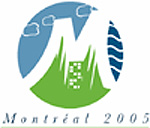 |
 |
Issue No.11 Winter
|
| ENS News |
| ENS Events |
| Etrap 2005 |
| Member Societies & Corporate Members |
| Modernizing Romanian Nuclear
Education and Traning Systems |
| European Institutions |
| ENS World News |
| COP 11 & COP/MOP 1 |
ENS Members |
| Links to ENS Member
Societies Links to ENS Corporate Members Editorial staff ______________________ |
| _____________________ |
| _____________________ |
| _____________________ |
|
|
|
|
|
|
(COP/MOP 1) took place in
Montreal, Canada, from 28 November to 10 December 2005.
The event drew 9500 participants, including 2800 government
officials, over 5800 representatives of UN bodies and agencies,
intergovernmental organisations and non-governmental organisations,
and 817 accredited members of the media. |
Summary:
At COP/MOP 1, parties discussed and adopted decisions on the outstanding operational details of the Kyoto Protocol, including a package of decisions known as the “Marrakech Accords.” These decisions contain guidelines for how the Protocol will function, such as those relating to the “flexible mechanisms” intended to help parties reach their emissions targets in a cost-effective way, and a compliance mechanism. COP/MOP 1 also took decisions on a process for considering further commitments for post-2012, when the Protocol’s first commitment period ends. Various methodological, administrative, financial and institutional matters were also considered.
COP 11 addressed issues such as capacity building, technology development and transfer, the adverse effects of climate change on developing and least developed countries, and several financial and budget-related issues, including guidelines to the Global Environment Facility (GEF), which serves as the Convention’s financial mechanism. After lengthy negotiations, the COP also agreed on a process for considering future action beyond 2012 under the UNFCCC.
The COP and COP/MOP were assisted in their work by the Subsidiary Body for Implementation (SBI) and the Subsidiary Body for Scientific and Technological Advice (SBSTA), which met from 29 November to 6 December. There were also over a twenty contact groups formed to help advance discussions, and a large number of informal consultations.
A joint COP and COP/MOP high-level segment was held from 7-9 December. Over 120 ministers and other high-level government officials made statements, along with senior representatives of observer organisations, UN bodies, specialised agencies and other stakeholders. Over 140 “side events” were held on a range of climate change topics, (reports can be found at www.iisd.ca/climate/cop11/enbots/). There were also several major “parallel events” organised with assistance from the host government, as well as numerous other climate and energy-related exhibits, displays, launches and initiatives.
In his closing comments early in the morning on 10 December, COP President Stéphane Dion declared the meetings a success, expressing satisfaction that they had avoided so many potential pitfalls and achieved a consensus outcome. With the Kyoto Protocol now operational and a post-2012 path now envisaged, most participants agreed that COP 11 and COP/MOP 1 was an important milestone in moving the process forward.
Source: Earth Negotiations Bulletin (Vol. 12 No. 291)
Significant Decisions
The negotiations in Montreal resulted in a total of 40 decisions being made. Here is a brief summary of the main outcomes:
-
The parties to the Kyoto Protocol agreed to set up a working group to start discussions on fixing larger emission cuts by industrialised countries after 2012. The group will meet for the first time next May. Its brief is to ensure continuity during the 2008-12 commitment period and beyond. By announcing that emission reductions will continue after 2012, the agreement reaffirms the Kyoto Protocol as the central driving force behind global climate change policy. It also sends a strong signal that carbon emissions will continue to have a market value in the future
-
The parties to the Protocol's parent climate change Convention have, in parallel, agreed to take part in a dialogue on the long-term actions required to tackle climate change and to report back to the next COP but one - in other words around the end of 2007
-
The key significance of this “parallel negotiations track” is that it will include developing countries and “Kyoto-refusenik” nations, like the USA and Australia. It keeps open the future possibility of a broader global negotiations framework involving all parties
-
The Marrakech Accords, or "Kyoto rule-book", were adopted, strengthening the legal framework for implementing the Protocol. Key elements of the rule book include agreements on a compliance regime to enforce the Protocol's rules, a stronger and better funded clean development mechanism (CDM) and the launch of a joint implementation (JI) process
-
The parties also agreed to launch a process for reviewing the Kyoto Protocol. The process will kick-off at the next annual conference, in late 2006
-
Under the Protocol's parent Convention, parties agreed a five-year work programme for identifying the impacts of climate change and adapting to it. A one-year process for defining how the Convention's adaptation fund will be operated was also launched. The parties reaffirmed the importance of technology development and transfer and agreed to start talks on possible support for forestation and reforestation
Nuclear highlights
COP 11 & COP/MOP 1 marked the return of a large nuclear delegation to the international climate change negotiations for the first time since COP 7 in Marrakech, in 2001. Approximately 30 representatives from the world’s nuclear industry participated, including a strong contingent from the European Nuclear Society Young Generation Network (ENS YGN) and the North American Young Generation in Nuclear (NA-YGN) network.

The nuclear industry manned two exhibition stands during the conference. One was located at the official UN venue and the other in a nearby site hosted by the Canadian government. Both stands were staffed by members of the NA-YGN. They provided visitors with general information about nuclear energy and its contribution to mitigating climate change, as well as with an opportunity to ask any questions on the subject. The stands proved popular, with plenty of visitors passing by. The stand at the UN venue was also popular with the international media.
In addition to the exhibition stands, the ENS YGN & NA-YGN organised an official evening side event, on 5 December. The event, which was entitled Let’s Take a Fresh Look at Nuclear as Part of the Solution, was organised to present the facts and to highlight the main concerns that will underpin a constructive debate on deciding what criteria and values should be applied when determining nuclear energy’s role in addressing environmental and economic issues. At the event, a presentation was given by Dr. Patrick Moore (the former founder of Greenpeace, well-known environmentalist and advocate of nuclear energy) who expressed his views on how nuclear energy must be a central part of the solution to the problem of global warming. The event attracted approximately 120 participants and the ensuing debate was very lively. Unfortunately, the views expressed proved just how polarised the nuclear debate still is.
In addition to the ENS YGN & NA-YGN side event, the Japan Atomic Industrial Forum (JAIF) also organised a side event, on 29 November, called Clean Energy Technology Transfer in Asia Pacific. It focused upon the energy situation in Asia-Pacific partner countries, potential clean energy technology transfers and how to remove barriers to such transfers.
On 2 December, the International Atomic Energy Agency (IAEA) and the OECD Nuclear Energy Agency (OECD/NEA) organised an event called Global Status and Outlook for Nuclear Power. The event reviewed recent forecasts and national plans, put the spotlight on evolving markets and underlined the impact of greenhouse gas constraints.
On the flip side, the Heinrich Boll Foundation (HBF) organised a panel discussion, on 7 December called Nuclear Energy - No Solution to Climate Change. This event sought to counter the growing acceptance around the world of nuclear energy’s frontline role in the fight against climate change. A paper attempting to downgrade nuclear energy’s contribution was presented by the Heinrich Böll Foundation, a think-tank affiliated to the German Green party. It gave an overview of nuclear power in the energy sector and tried to undermine nuclear energy’s effectiveness. Among the speakers were Rebecca Harms, a German MEP from the Green Party. The event was well-attended by representatives of the nuclear industry. This was particularly noticeable when it came to the questions and answers session. A majority of the questions and comments came from the nuclear industry lobbyists, who attempted to rebuff many of the panellists’ assertions and eventually placed a cloud of doubt over the statements that the panellists made. Once again, the polarised nature of the debate was clear for all to see.
On 7 December, the nuclear industry organised a special reception celebrating the 11th anniversary of the forming of the Convention of the Parties and the achievements of nuclear energy in addressing climate change. The reception brought together government officials, national and regional legislators and industry leaders to informally discuss nuclear energy’s climate change credentials and its role in a future global climate change regime. The event was co-sponsored by the Canadian Nuclear Association (CNA), FORATOM, the European Nuclear Society (ENS), the Japan Industrial Atomic Forum (JAIF), the Nuclear Energy Institute (NEI) and the World Nuclear Association (WNA). Around 50 delegates attended.
Here are some useful links:
Decisions adopted by COP 11 and COP/MOP 1
Reactions and statements from EU Environment Commissioner, Stavros
Dimas:
8
December
11
December
| |



